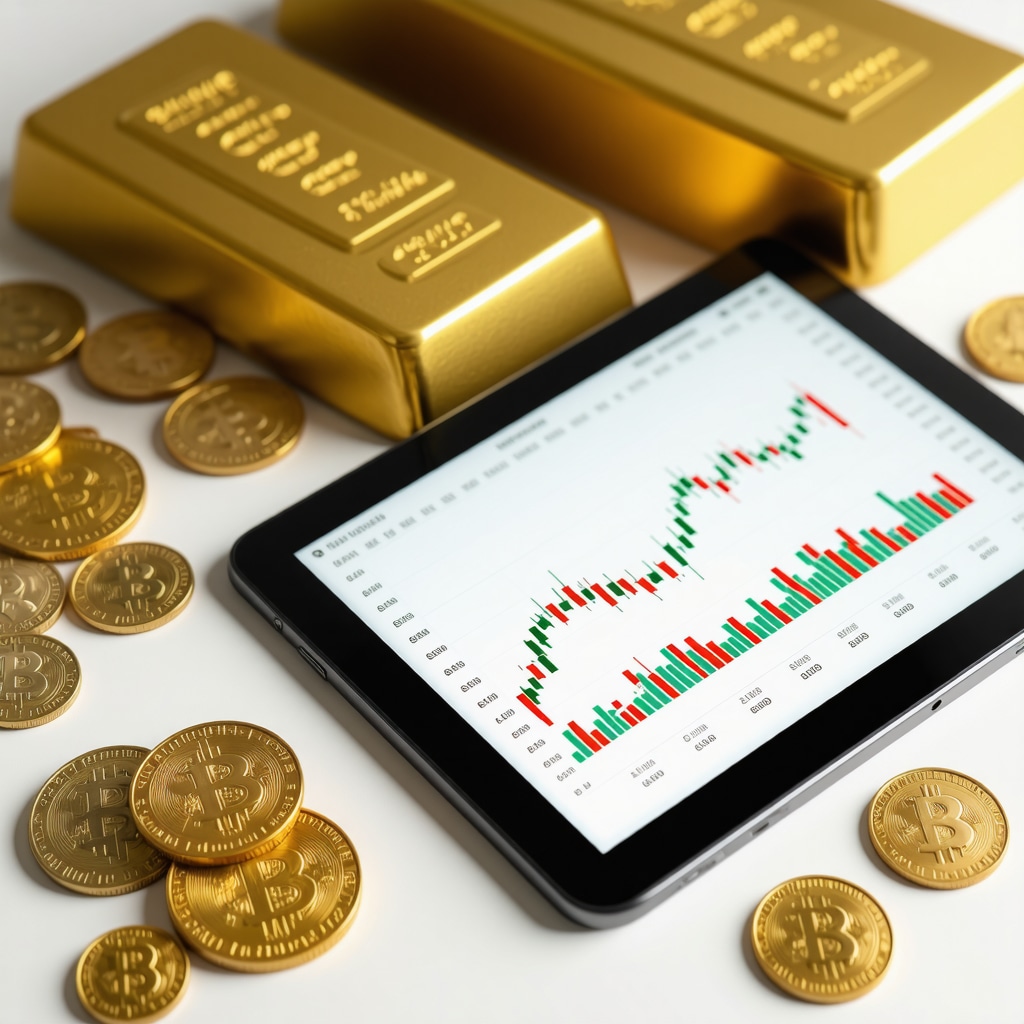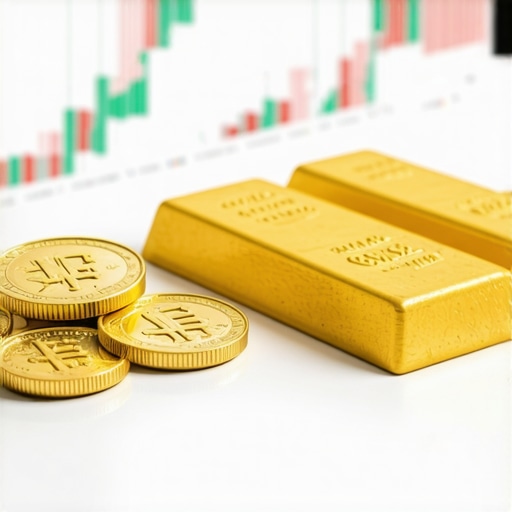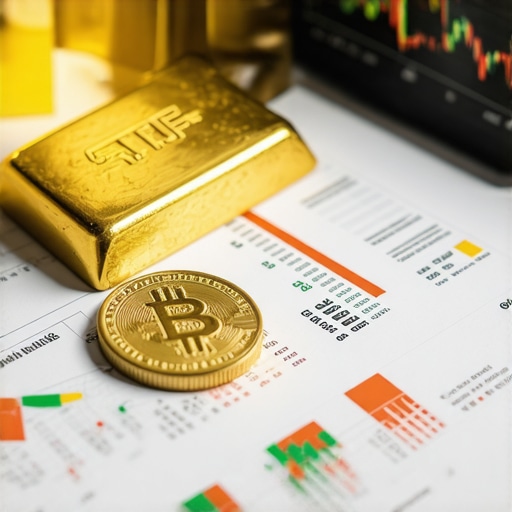Unlocking the Golden Spectrum: Diverse Avenues for Gold Investment
Gold has long been synonymous with wealth preservation and financial security, but its investment landscape is far richer and more nuanced than the mere possession of shiny bars. From physical gold to sophisticated financial instruments, understanding the types of gold investments available can empower you to craft a portfolio that balances risk, liquidity, and potential returns. This exploration dives into the multifaceted world of gold investments, helping you discern which option aligns best with your financial goals and risk appetite.
Physical Gold: Tangible Wealth with a Timeless Allure
Investing in physical gold, such as bullion bars and coins, offers the palpable satisfaction of owning a concrete asset. This form serves as a direct hedge against inflation and currency fluctuations. Yet, it demands careful consideration of storage, insurance, and authenticity verification. For instance, gold coins like the American Eagle or Canadian Maple Leaf not only carry intrinsic metal value but often hold numismatic appeal that can enhance returns. However, new investors should heed expert advice on secure purchasing practices, as detailed in the Physical Gold Investment Guide.
Gold ETFs and Mutual Funds: Liquid Exposure Without the Hassle
For those seeking gold exposure without the complexities of physical ownership, gold Exchange-Traded Funds (ETFs) and mutual funds provide a streamlined alternative. These instruments allow investors to buy shares that track the price of gold or invest in gold-related assets, such as mining companies. The liquidity and ease of trading on stock exchanges make ETFs an attractive choice for portfolio diversification. However, investors must evaluate fund management fees and tracking accuracy. Comprehensive comparisons between gold ETFs and mutual funds can be found in the insightful article Gold ETFs vs Mutual Funds.
Mining Stocks and Gold Futures: High-Risk, High-Reward Frontiers
Venturing into gold mining stocks or futures contracts introduces higher volatility but also the potential for significant gains. Mining stocks reflect company performance and operational risks alongside gold price movements, requiring diligent fundamental analysis. Futures contracts, meanwhile, offer leveraged exposure and sophisticated strategies for traders adept at market timing. Understanding these instruments demands expertise; resources like the Gold Futures Trading Guide provide essential strategies to navigate these complex markets effectively.
What factors should you consider when choosing the best type of gold investment?
Choosing the right gold investment depends on multiple factors: your investment horizon, liquidity needs, risk tolerance, and familiarity with financial markets. For example, physical gold suits those prioritizing asset tangibility and long-term wealth preservation, while ETFs and mutual funds cater to investors seeking convenience and market liquidity. Mining stocks and futures appeal to risk-tolerant individuals aiming for active portfolio growth. Additionally, costs such as storage fees for physical gold and expense ratios for funds can impact net returns. Balancing these elements, along with current market conditions and gold price forecasts, is crucial to making an informed decision.
Engage with this gold investment journey by sharing your experiences or questions in the comments below — your insights enrich the collective knowledge for all enthusiasts.
For authoritative insights on gold as a strategic asset, the World Gold Council offers extensive research and market analysis, supporting informed investment decisions.
Strategic Diversification: Integrating Gold with Broader Portfolio Assets
Effective portfolio management often hinges on diversification, and gold holds a unique position as a non-correlated asset relative to equities and bonds. Incorporating various forms of gold investments, such as physical bullion, ETFs, and mining stocks, can optimize risk-adjusted returns. For instance, pairing physical gold’s stability with mining stocks’ growth potential provides a balance between security and upside. Moreover, blending gold ETFs with traditional asset classes enhances liquidity and flexibility in portfolio rebalancing.
Investors should consider their overall exposure to gold carefully; over-concentration can introduce risks, especially when market volatility spikes. As noted by the World Gold Council, a typical allocation of 5-10% in gold can meaningfully reduce portfolio risk without sacrificing returns.
Gold Investment Tax Considerations: What Every Investor Needs to Know
Tax implications can substantially affect net returns from gold investments. Physical gold is often classified as a collectible in many jurisdictions, subject to higher capital gains tax rates compared to other investments. Conversely, gold ETFs and mutual funds might benefit from more favorable tax treatment depending on fund structure and local laws.
Additionally, mining stocks may incur dividend taxes and capital gains taxes. Investors need to understand these nuances and plan accordingly, possibly consulting tax professionals to optimize after-tax gains. Staying informed about evolving tax regulations is essential to avoid unexpected liabilities that could erode investment gains.
Technological Innovations: How Digital Gold and Blockchain Are Changing the Game
Emerging technologies have introduced novel gold investment avenues such as digital gold tokens and blockchain-backed assets. These innovations aim to combine the security of physical gold with the convenience of digital transactions. Digital gold platforms allow fractional ownership and instantaneous settlement, broadening access to gold investment for retail investors worldwide.
However, these platforms also introduce new risks including regulatory uncertainty, counterparty risk, and cybersecurity vulnerabilities. Investors should rigorously evaluate platform credibility, custody arrangements, and compliance with financial regulations before committing capital.
How can investors effectively balance traditional and innovative gold investment options in 2025?
Balancing traditional gold assets like bullion and mining stocks with innovative digital gold products requires a nuanced strategy. Traditional assets offer tangible security and longstanding market acceptance, while digital gold products enhance liquidity and accessibility. Investors should assess their risk tolerance, investment horizon, and comfort with technology to allocate appropriately across these options.
In practice, a core-satellite approach may work well: maintain a core holding in physical gold or ETFs for stability, while allocating a smaller satellite portion to digital gold or mining equities for growth potential. Continuous monitoring of market developments and regulatory changes is vital to adapt this balance effectively.
For further expert strategies on integrating gold into diversified portfolios, explore Smart Gold Investment Strategies for Diversification.
We encourage readers to share their own balancing strategies or questions about emerging gold investment trends in the comments section below. Your contributions help foster a richer community discourse.
Mastering Gold Volatility: Sophisticated Risk Management Techniques for Seasoned Investors
While gold is traditionally viewed as a safe haven, its price can exhibit significant volatility influenced by macroeconomic factors, geopolitical events, and speculative trading. Advanced investors recognize that volatility is not merely a risk but also an opportunity to optimize entry and exit points for maximized returns. Employing sophisticated risk management techniques such as options hedging, stop-loss orders, and dynamic asset allocation can mitigate downside while capitalizing on upward price momentum.
For example, using gold options strategies like protective puts or covered calls can provide downside protection without sacrificing upside potential. Additionally, integrating volatility indicators such as the Gold Volatility Index (GVZ) into trading models enables more informed timing decisions. These strategies require a deep understanding of derivatives and constant market monitoring but offer a powerful toolkit for navigating gold’s price fluctuations.
How can advanced investors effectively apply derivatives to hedge against gold price volatility?
Derivatives, notably options and futures, offer strategic flexibility to hedge gold exposure or speculate with defined risk parameters. Protective puts allow investors to insure their physical or paper gold holdings by securing the right to sell at a predetermined price, thus limiting losses during downturns. Covered calls generate income by selling call options on owned gold assets, which can offset holding costs but cap upside gains.
Futures contracts provide leveraged exposure but require disciplined margin management and precise market timing due to the risk of significant losses. Successful application of these instruments hinges on rigorous analysis of implied volatility, time decay, and strike price selection aligned with the investor’s risk tolerance and market outlook.
Authoritative guidance on this topic is available in the CME Group’s Gold Futures and Options Education, which offers in-depth resources on structuring effective hedges and leveraging derivatives in gold markets.
Macro-Economic Integration: Leveraging Gold Investment Amidst Global Financial Dynamics
Gold’s performance is intricately linked to global economic indicators such as interest rates, inflation expectations, currency strength, and geopolitical tensions. Advanced investors synthesize these macroeconomic signals to anticipate shifts in gold demand and price trajectories. For instance, rising real interest rates historically dampen gold’s appeal as they increase opportunity costs of holding non-yielding assets.
Conversely, periods of expansive monetary policy and elevated inflation expectations often correlate with gold price appreciation. Currency depreciation, especially of the US dollar, typically boosts gold’s dollar-denominated price due to inverse correlation dynamics. Strategic investors monitor central bank policies, Treasury yields, and inflation data releases to adjust their gold allocation dynamically.
What macroeconomic indicators are most predictive of gold price movements in complex financial environments?
Historical and empirical research indicates that key predictors include the real yield on 10-year Treasury Inflation-Protected Securities (TIPS), the US Dollar Index (DXY), and global geopolitical risk indices. Real yields are inversely correlated with gold prices; as real yields decline, gold tends to rally. The DXY’s movements also strongly impact gold due to global trade and investment flows.
Moreover, geopolitical risk measures, such as the Global Peace Index or conflict event frequency, can trigger safe-haven demand, driving gold prices higher. Monitoring these indicators within a comprehensive, algorithmic or discretionary framework enhances predictive accuracy for gold investment timing.
For empirical validation, see the detailed analysis in the World Gold Council’s research on gold and macroeconomic indicators.
Innovative Portfolio Construction: Combining Gold with Alternative Assets for Superior Diversification
Beyond traditional equity and bond mixes, integrating gold with alternative investments such as real estate, cryptocurrencies, and private equity can elevate portfolio diversification and resilience. Gold’s low or negative correlation to these assets offers unique hedging qualities, particularly during systemic shocks.
Advanced portfolio managers utilize multi-asset optimization models that incorporate gold’s covariance with emerging asset classes to calibrate allocations that minimize portfolio volatility while targeting specific return objectives. In addition, tactical rebalancing strategies that respond to shifts in correlation regimes maximize diversification benefits.
How do dynamic correlation shifts between gold and alternative assets influence portfolio optimization strategies?
Correlation between gold and other asset classes is not static; it fluctuates across economic cycles and market stress periods. During crises, gold’s safe-haven status often strengthens its negative correlation with risk assets, enhancing its diversification value. However, in bullish markets, correlations may converge, reducing incremental diversification benefits.
Dynamic portfolio optimization requires continuous recalibration based on updated correlation matrices and scenario analyses. Techniques such as regime-switching models and machine learning algorithms can detect structural breaks and adapt allocations accordingly, ensuring portfolios remain robust across varying market conditions.
Leading-edge research in this domain is available through the Journal of Portfolio Management’s study on gold’s evolving correlation dynamics.
Understanding and applying these advanced concepts can significantly enhance your gold investment strategy, positioning you to navigate complexity with confidence. To deepen your expertise, consider subscribing to specialized market analysis and engaging with professional forums dedicated to precious metals investing.
Decoding Gold Volatility: Harnessing Market Fluctuations for Strategic Gains
Seasoned investors recognize that gold’s price volatility, often perceived as a risk, offers a fertile ground for sophisticated risk management and profit optimization. Employing derivatives such as options and futures, alongside tools like the Gold Volatility Index (GVZ), enables active traders to tactically position in response to dynamic market swings. Techniques including protective puts and covered calls serve not only as hedges but also as income-generating mechanisms, balancing downside protection with upside potential. Mastery of these instruments requires deep expertise in derivatives and vigilant market monitoring.
Macroeconomic Intelligence: Leveraging Global Indicators to Forecast Gold’s Trajectory
Integrating macroeconomic data into gold investment decisions can significantly enhance timing and allocation precision. Real yields on inflation-protected securities, movements in the US Dollar Index (DXY), and geopolitical risk metrics are among the most predictive signals for gold price dynamics. Declining real yields typically bolster gold’s allure, while geopolitical tensions often precipitate safe-haven inflows. Advanced investors employ algorithmic models and discretionary analysis to synthesize these multifaceted indicators, enabling a proactive stance amid evolving global financial landscapes.
Which macroeconomic variables should expert investors prioritize for anticipating gold price shifts?
Top-tier gold strategists focus on the real yield of 10-year Treasury Inflation-Protected Securities (TIPS), the strength and volatility of the US Dollar Index, and comprehensive geopolitical risk indices such as the Global Peace Index. These variables collectively capture inflation expectations, currency dynamics, and risk sentiment that drive gold demand. Rigorous empirical studies, like those from the World Gold Council, validate the predictive power of these indicators, emphasizing their integral role in advanced portfolio management.
Innovative Portfolio Architectures: Gold’s Synergy with Alternative Investments
In an era of complex asset interdependencies, constructing portfolios that exploit gold’s unique correlation properties can substantially enhance resilience and returns. By pairing gold with alternatives such as real estate, cryptocurrencies, and private equity, investors achieve diversification benefits unattainable through traditional asset mixes alone. Cutting-edge portfolio optimization models incorporate dynamic correlation assessments and regime-switching algorithms to adjust allocations responsively. This adaptive approach ensures portfolios remain robust, mitigating systemic risks while capitalizing on growth opportunities.
How do shifting correlations between gold and alternative assets refine portfolio optimization strategies?
Correlations between gold and other asset classes fluctuate with economic cycles and market stress events. During systemic shocks, gold often exhibits strengthened negative correlation with equities and risk assets, amplifying its hedging effectiveness. Conversely, in bull markets, these correlations may diminish, necessitating agile rebalancing. Employing regime-switching models and machine learning techniques allows portfolio managers to detect structural shifts and recalibrate exposures accordingly, optimizing risk-adjusted returns across heterogeneous market environments. The Journal of Portfolio Management offers comprehensive research substantiating these dynamic strategies.
Exploring these advanced methodologies will elevate your gold investing acumen. Engage with our expert community by sharing your insights or inquiries below, and stay informed with the latest research and strategic recommendations.
Frequently Asked Questions (FAQ)
What are the main advantages and disadvantages of investing in physical gold?
Physical gold offers tangible ownership and serves as a reliable hedge against inflation and currency risk. It provides security during systemic financial crises due to its intrinsic value. However, drawbacks include storage costs, insurance requirements, liquidity constraints, and risks related to authenticity and theft. Investors must weigh these factors against their investment goals and comfort with asset custody.
How do gold ETFs differ from gold mutual funds, and which is better for investors?
Gold ETFs trade like stocks on exchanges, providing intraday liquidity and generally lower expense ratios. They track gold prices closely and often hold physical bullion or futures contracts. Gold mutual funds may invest not only in physical gold but also in mining equities and related assets, potentially offering diversified exposure but with higher fees and less trading flexibility. The choice depends on the investor’s preference for liquidity, cost sensitivity, and exposure type.
What risks are associated with investing in gold mining stocks and futures contracts?
Gold mining stocks carry operational risks such as management performance, geopolitical exposure, and commodity price volatility, leading to more fluctuation than physical gold prices. Futures contracts offer leveraged exposure but come with margin calls and significant risk of loss if markets move unfavorably. Both require advanced market knowledge and risk management strategies to navigate effectively.
How does taxation impact returns from different types of gold investments?
Tax treatment varies by jurisdiction and investment type. Physical gold is often taxed as a collectible with higher capital gains rates, while ETFs and mutual funds might benefit from capital gains or dividend tax rules depending on fund structure. Mining stocks may incur dividend taxes alongside capital gains. Consulting tax professionals and understanding local laws is essential to optimize after-tax returns.
What role do macroeconomic indicators play in forecasting gold price movements?
Key indicators include real yields on inflation-protected securities, the US Dollar Index (DXY), and geopolitical risk indices. Generally, declining real yields and a weaker US dollar support rising gold prices, while geopolitical tensions increase safe-haven demand. Monitoring these variables helps investors anticipate gold’s market cycles and adjust allocations accordingly.
How can investors integrate digital gold and blockchain-based gold investments safely?
Digital gold tokens and blockchain platforms offer fractional ownership and ease of transaction but come with regulatory uncertainty, counterparty risk, and cybersecurity concerns. Investors should verify platform credibility, custody arrangements, and regulatory compliance before investing, and consider these products as a complement rather than a substitute for traditional gold holdings.
What sophisticated strategies exist for managing gold price volatility?
Advanced investors use derivatives such as options (protective puts, covered calls) and futures to hedge downside risk or generate income. Incorporating volatility indices like the Gold Volatility Index (GVZ) into timing and risk models enhances decision-making. These techniques require expertise in derivatives, disciplined risk management, and continuous market monitoring.
How does gold’s correlation with alternative assets affect portfolio construction?
Gold’s correlation with other assets varies across economic cycles and market conditions. During crises, gold’s negative correlation with equities enhances diversification benefits, while in bull markets correlations may rise, reducing incremental gains. Dynamic portfolio optimization models that adapt to shifting correlations improve risk-adjusted returns by recalibrating allocations responsively.
What is an optimal allocation of gold in a diversified investment portfolio?
Experts generally recommend allocating between 5-10% of a portfolio to gold to reduce overall risk without significantly sacrificing returns. This allocation can be adjusted based on individual risk tolerance, investment horizon, and prevailing market conditions. Overconcentration in gold may increase portfolio risk, especially during price corrections.
How can investors balance traditional and innovative gold investment options effectively?
A core-satellite approach works well: maintain core holdings in physical gold or ETFs for stability and liquidity, while allocating smaller satellite positions to mining stocks or digital gold products for growth potential. This balance aligns with risk appetite and technological comfort, while ongoing monitoring ensures responsiveness to market and regulatory developments.
Trusted External Sources
- World Gold Council – As the authoritative global organization dedicated to gold, it provides comprehensive research on gold demand, macroeconomic influences, and portfolio diversification strategies, offering invaluable market insights for investors.
- CME Group Education Center – A leading resource for understanding gold futures and options trading, it delivers in-depth educational materials crucial for mastering derivatives-based gold investment strategies.
- Journal of Portfolio Management – This peer-reviewed publication features advanced research on asset correlation dynamics and portfolio optimization techniques involving gold, aiding sophisticated investors in building resilient portfolios.
- Global Peace Index and Geopolitical Risk Reports – These indices quantify geopolitical tensions that often drive safe-haven demand for gold, helping investors incorporate risk sentiment into their macroeconomic analysis.
- Tax Authorities and Financial Regulators (e.g., IRS, HMRC) – Official guidelines and rulings on taxation of gold investments are essential for understanding jurisdiction-specific implications and ensuring compliance.
Conclusion
Gold remains a multifaceted and potent component of an investment portfolio, offering unique advantages in wealth preservation, diversification, and tactical growth. From tangible physical bullion to innovative digital tokens, each gold investment avenue carries distinct characteristics, risks, and rewards. Mastery involves understanding market volatility, macroeconomic drivers, tax implications, and evolving technological innovations. Integrating gold thoughtfully alongside alternative assets amplifies portfolio resilience amid global financial uncertainties.
Armed with advanced knowledge and strategic insights, investors can harness gold’s full potential to optimize returns and mitigate risks. We invite you to share your experiences, pose questions, and explore further expert content to deepen your mastery of gold investing. Engage with this vibrant community and elevate your portfolio’s performance through informed gold investment strategies.










